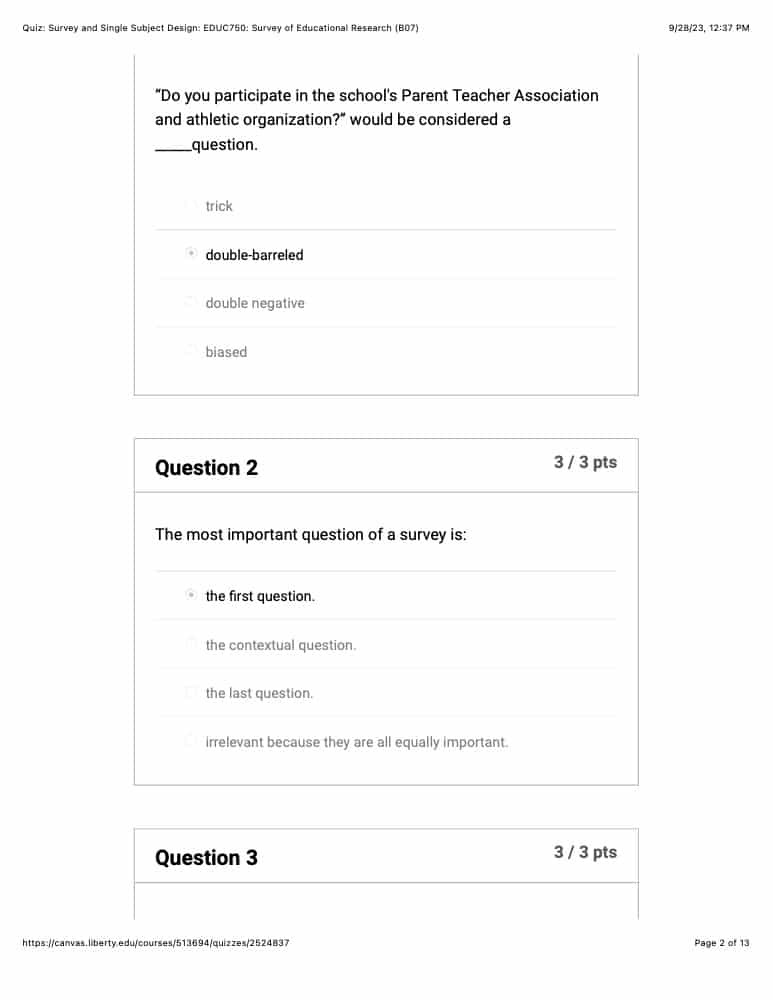EDUC 750 Quiz Survey and Single Subject Design
EDUC 750 Quiz Survey and Single Subject Design
Covers the Learn material from Module 7: Week 7.
- “Do you participate in the school’s Parent Teacher Association and athletic organization?” would be considered a _____question.
- The most important question of a survey is:
- Which type of survey administration is NOT completed by the respondents themselves?
- Which one of the following guidelines will help an interviewer maintain balance in an in-person interview?
- A series of questions that concern a common theme and have the same response choices are called _____ questions.
- Which technique for improving survey questions involves having individuals think aloud as they answer the questions?
- Which three qualities best describe survey research?
- When is the potential for context effect the greatest?
- The frequent use of cell phones has increased the popularity of phone surveys.
- One way to ensure that possibly relevant questions are asked is to use questions suggested by prior research, theory, experience, or experts (including participants) who are knowledgeable about the setting under investigation.
- One way a researcher can ensure that relevant questions are asked in a survey is to investigate questions suggested by prior researchers.
- When designing a questionnaire, the research objective is the basis for deciding what to include or exclude.
- In a study examining a third grader’s feelings of self-esteem in the classroom, the child’s level of self esteem would likely be measured by:
- In visual analysis, the amount or magnitude of the target variable is referred to as the:
- In monitoring using single-subject design, when do the target and intervention emerge?
- As long as threats to internal validity are controlled, an A-B design is analogous to:
- Which type of design implements a series of A-B designs at the same time for at least three cases?
- The baseline phase is signified by the letter(s)____; whereas the treatment phase is signified by the letter(s)_____.
- Which principle is NOT involved in determining practical significance?
- In the Hume and Odom (2007) study, what was the name of the intervention teachers instituted to help Scott?
- What occurs when scores are either increasing or decreasing during the baseline phase?
- Rate, magnitude, and level are three concepts involved in visual analysis.
- In a single-subject design, the focus of the intervention is the independent variable.
- Establishing a pattern in single-subject design requires four measurements.
- Historically, single-subject designs have been underutilized by school-based practitioners and educational researchers.
Other sets
- The most important question of a survey is:
- A series of questions that concern a common theme and have the same response choices are called _____ questions.
- According to the authors, which pretesting method identifies the greatest number of problems with questions?
- Which agency commissioned the 2000 National Survey of Science and Mathematics Education?
- The way questions are written, and the characteristics of the respondents can lead to:
- The below question illustrates a_____ question with a _____.
- Which type of survey has the strongest design?
- According to the authors, the only good question is a(n) _____question.
- Open-ended questions are useful when the researcher wants to learn as much as possible about a topic.
- When designing a questionnaire, the research objective is the basis for deciding what to include or exclude.
- One way a researcher can ensure that relevant questions are asked in a survey is to investigate questions suggested by prior researchers.
- In order to maintain confidentiality in survey research it is crucial that all surveys are completed anonymously.
- What occurs when scores are either increasing or decreasing during the baseline phase?
- The baseline phase is signified by the letter(s)____; whereas the treatment phase is signified by the letter(s)_____.
- In a study examining a third grader’s feelings of self-esteem in the classroom, the child’s level of self-esteem would likely be measured by:
- Which design only has an intervention phase?
- Which of the following is NOT a characteristic of single-subject design?
- Which principle is NOT involved in determining practical significance?
- Baseline measures should include at least _____ data point(s).
- Which type of pattern displays scores that fall in a narrow band?
- How are the baseline and treatment phase measurements displayed in single-subject designs?
- The more measures are taken in single-subject design, the more certain you will be about a pattern.
- Multiple baseline design can be implemented with one subject, with the same intervention applied to different, but related, problems and behaviors.
- A school is an example of a single subject design.
- Rate, magnitude, and level are three concepts involved in visual analysis.
